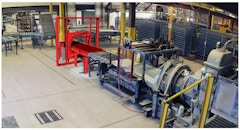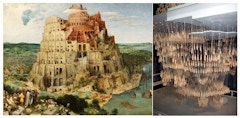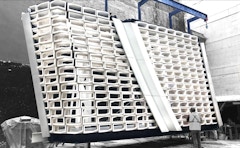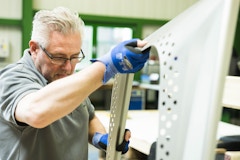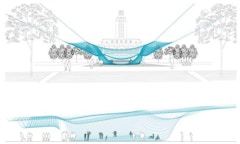
28 results
-
 Big data is having a noticeable impact on enclosure engineering design. With continuing advancements that liberate the geometrical form and the…
Big data is having a noticeable impact on enclosure engineering design. With continuing advancements that liberate the geometrical form and the… -
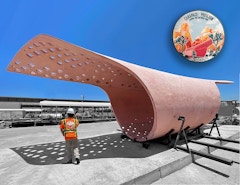
The Carapace Pavilion
- Paper by Douglas Noble, PhD, FAIA · Karen M. Kensek, DPACSA
The Carapace Pavilion is a university-based, design-build, full-scale custom prototype for a possible replacement of the standard precast concrete
-

Hybrid Timber
- Paper by Stacey Hooper, AIA, LEED BD+C,
This case study provides an overview of building hybrid curtain wall system and future opportunities for the use of timber. It will also review the… -

Printed Facades?
- Paper by Philipp L. Rosendahl · Chris Borg Costanzi · Philipp A. Chhadeh · Robert Akerboom · Benedikt Waldschmitt · Alexander Wolf · Marvin Kehl · Ulrich Knaack
While additive manufacturing (AM) offers unprecedented freedom of design and a remarkable potential for material efficiency and lightweight
-
Design Digital Recipes
- Paper by Trevor Stephen Lewis, PhD, PE · Lukasz Blonski · Jessica Chen, PE
Precision in digital workflow is necessary to deliver facade projects where there is a high design aesthetic or structural performance requirement.
-
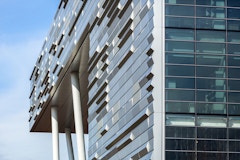
Sculptural Facades
- Paper by Matthew A. Trimble · Matthew Culver
In the vein of mass production, manufacturers leverage repeatable parts and modular construction in an effort to maximize quality control while
-
Detailing & Engineering Of Complex Geometry Copper Panels
- Paper by Becher Eli Neme · Thomas Johnson
Paper Abstract with photos and illustrations Detailing and Engineering of copper panels with complex geometries: A case study in developing a
-
Honing the Craft
- Paper by Patrick Delorey
Finishing of custom-fabricated architectural façade components represents one of the most significant components to their cost. Manually driven
-
Architectural Ceramic Assemblies
- Paper by Omar Khan · Bill Pottle · Mitchell Bring
This paper documents a six year academia/industry collaboration between researchers at the Department of Architecture, University at Buffalo (SUNY)
-

Build Test Iterate Repeat
- Paper by Elizabeth L McCormick, RA, CPHC, LEED AP, Assistant Professor
The global increase in atmospheric temperature rise combined with the rapid growth of previously underdeveloped climate zones presents a growing need… -
Digital Medium, Tangible Message
- Paper by Nathaniel Barlam
The reaches of architecture are inherently linked to the efficacy of communication, and as emerging technology broadens the conceptual horizon of the
-
Reinforced Polymer Concrete Screen Walls
- Paper by Brock DeSmit · Jessica Hong · Becher Eli Neme
Apertures is a six-story, commercial building in the Roma Norte neighborhood of Mexico City–a neighborhood severely impacted by the 1985 and 2017
-
Hydroformed Shading
- Paper by Michelle Siu-Ching Lee · Robert Matthew Noblett · Roman Schieber
New approaches to lightweight metal forming have the potential to advance architectural fabrication, particularly in the design and engineering of
-
Curved Forming Panel Facades
- Paper by Roger Schroeder
The performative and visual aspects of curved forming/bending thin “formable” planar materials is explored. Early tests for deflection indicate that
-
Fit for the Future
- Paper by Julia Koerner-Al-Rawi, Associate Adjunct Professor, Director of Summer Programs, Department of Architecture and Urban Design
Wearables protect us from climatic conditions, they provide privacy, comfort and they also reflect our style and personality. Building facades in the… -

Digital Enablement for Manufacturing
- Paper by Melody Rees
Architectural design freedom achieved on high-end projects currently costs over $1,000/sq. Ft. Building materials have long been relegated to plane
-

Terra Cotta Skins
- Paper by Laura B. Garofalo, Assistant Professor
This paper will address the potential of ornamental architectural terracotta surfaces to mitigate the effects of climate fluctuations that will… -
Localized Rigidification of PCM Envelopes
- Paper by Elnaz Tafrihi
This is an experimental and computational exploration of structural systems that transform between states of rigidity and flexibility. The goal is to
-
Patchwork
- Paper by Alexander G. Worden, AIA
It may be difficult for modern man to believe that what is known as handicraft was once the advanced manufacturing of the day. These techniques were
-

Digital Lifecycle of Building Envelopes
- Paper
“The digital transformation will change everything” – with this quote in mind a deep look into the current facade business will be given with a…

